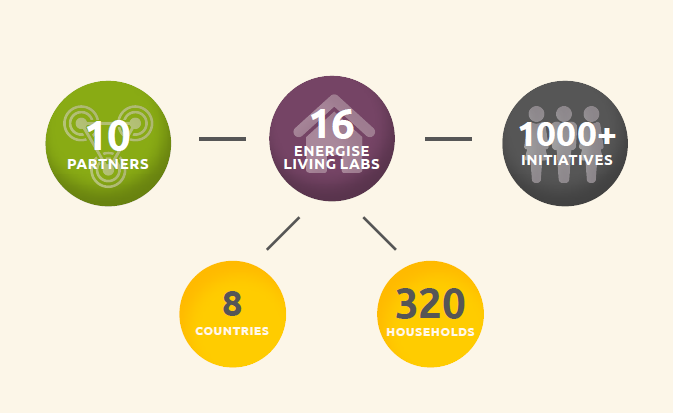What role can households play in the energy transition? Can changes to everyday practices make a difference? The European ENERGISE project, led by the National University of Ireland in Galway and the University of Geneva (UNIGE) for the swiss participation, carried out an experiment to reduce energy consumption in 320 households in eight countries. The goal was to lower room temperatures to 18°C and to halve the amount of washing cycles over a four-week period, and for each challenge. The results indicated that, if all households in Switzerland were to participate, the changes would result in lowering energy consumption by up to 6%, 13 million m3 of water saved, along with an hour a week saved from household chores – without any significant impacts on comfort levels.

Author
Marlyne Sahakian
Assistant Professor of Sociology at the University of Geneva.
About
Understanding social and cultural influences on energy consumption.
Moving from behavioral change to practice change
Given the climate crisis we are experiencing, energy transitions have a pivotal role to play, which is why initiatives that aim at more sustainable energy usage in the home have become more common in recent years. However, 75% of such EU initiatives are aimed at encouraging all of us to make technical changes (such as replacing incandescent light bulbs with LEDs) or individual, behavioural changes (switching off lights, for example). “But that’s not enough,” says Marlyne Sahakian, a professor in UNIGE’s Faculty of Social Sciences. “For there to be real change, we have to tackle energy consumption in relation to everyday life in all its complexity, meaning we need to account for socio-cultural aspects, such as social norms in relation to comfort levels and hygiene.” A social practice approach to everyday life is one way of moving beyond an individualized approach to consumption.
A focus on two consumption domains: heating and laundry
ENERGISE operated in eight European countries and tracked 320 households, including 36 in Switzerland, using a “living labs” approach. As professor Sahakian explains: “The idea wasn’t to impose a certain type of behaviour on people but to join them in thinking about how energy consumption relates to their everyday lives.” Two important areas were targeted by the project: heating and laundry. Heating was an obvious choice, as energy usage for heating is significant across Europe. However, the research team also wanted to tackle practices that are tied up with social norms that are difficult to change; because laundry has to do with representations of hygiene and cleanliness, it was a perfect second choice.
ENERGISE subsequently set two challenges: to lower room temperatures in the homes to 18°C and to halve the laundry cycles, each for four weeks. “To support the households, we gave them challenge kits containing items to help them stay warm (such as socks, hot chocolate, etc.) and avoid doing laundry (a clothes brush, apron, natural stain remover, etc.),” continues professor Sahakian.
Energy consumption cut by a minimum of 6%
The Swiss households managed to make significant changes to their everyday practices over these weeks, without any technological changes. The researchers found that the 1°C drop in room temperature had no impact on the normal comfort levels of the inhabitants while resulting in an energy saving of 6%, almost twice the energy needed for all their laundry and drying requirements. Although few households succeeded in meeting the 18°C target, given the unusually warm winter climate among other factors, householders who lowered the temperature by 1 to 3°C did have to wear warmer clothes at home instead of wearing teeshirts and going barefoot – but they also felt a positive impact on their health, especially in their bedrooms for sleeping at night.
One less laundry washing per week per Swiss household for a year represents a saving of around 13 million m of water (more than 5,000 Olympic-size swimming pools), 10 million litres of laundry products and the equivalent annual electricity consumption of 90,000 3 households. “And that’s not counting the time spent sorting, ironing and storing laundry – a saving of about an hour of domestic work a week, and a lessing of the ‘mental load’ related to the organization of laundry-related chores,” says professor Sahakian.
Changing social practices
Many of our everyday activities result from the way we represent social norms, such as putting on new clothes every day and washing them when they’re still clean. “Sometimes it’s just a matter of airing them out or getting rid of a small stain without actually doing a laundry cycle,” says the researcher. The room temperature in our homes has jumped from 15°C to 22°C over the course of a century thanks to advances in technology, which have shifted comfort levels to higher temperatures. But at the same time, people have come to expect warmer temperatures year round indoors – without a consideration for micoclimate diversity.

But not everyone feels comfortable at 22°C, with some people preferring it to be cooler, others hotter. So, standards of comfort indoors are still quite varied. People with reduced mobility require more heating, for example. In any case, being aware of the relative nature of our standards and expectations means we can challenge the norms and representations that underpin our practices. The majority of the ENERGISE households incorporated new ways of living in their homes, during and after the challenges, but the aim would be to understand how changes in everyday practices could take place across society as a whole. “The concept of energy saving is abstract, which is why we need to link it to comfort. Our results show that households who are not experiencing energy poverty but living around 20 or more degrees in their home, can reduce the thermostat by just 1°C, without changing their levels of comfort. But the energy savings are well and truly there”, says professor Sahakian. A reduction of one degree alone saves 6% of the energy used for heating, while the objectives of the 2050 Energy Strategy, agreed by parliament in 2017, are built on a 13% reduction in energy consumption per person in 2035 compared to the year 2000.
About the author

Marlyne Sahakian
Marlyne Sahakian is Assistant Professor of Sociology at the University of Geneva, and brings a sociological lens to consumption studies and sustainability. Her research interest is in understanding everyday practices in relation to environmental promotion, social equity and social change. She is a co-founder of SCORAI Europe, a network for sustainable consumption research and action, and a member of ENOUGH, a network focused on sufficiency.

